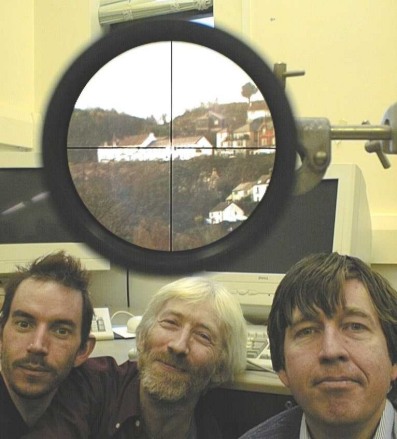
PRESS RELEASE
January 2001
DERA Scientists achieve world record 1.9km range for free- space secure key exchange using quantum cryptography.
 |
Recent experiments at DERA Malvern have shown that a low light level communication scheme can work out to a range greater than 1.9km. In the system individual photons (fundamental particles of light) are used to encode the data. Photons, being quantum particles, are indivisible and only one person can receive the encoded photon hence providing security. However in any realistic system most photons are lost in transmission and no sensible message can be sent. The Malvern system is not used to send any message but it is used to establish identical random numbers at transmitter and receiver. These large random numbers can then be used as CRYPTOGRAPHIC KEYS for encoding and decoding data on a standard communications link. Hence the technique is popularly known as quantum cryptography. |
Laws of physics guarantee security: The scheme guarantees the security of the exchange by exploiting the well-known law of Physics, Heisenberg's uncertainty principle. Any eavesdropper measuring the photons in a non-destructive way will necessarily disturb them leading to detectable errors between the two keys.
Global key exchange: This experiment is the first step towards a key exchange system operating from ground level to low earth orbit satellites which could form the basis of a global key exchange system.
The Malvern experiment: To avoid air turbulence effects the experiment was carried out over an elevated path with the receiver on the DERA Malvern site and the transmitter located in a rented room in a conveniently situated pub on the side of the Malvern hills. Initial alignment was achieved by shining a low power green laser from the Malvern site. The pencil of green light was clearly seen by the trials crew and a few late night revellers who passed it off as mild hallucinations. When aligned, of course, the single photon pulses were effectively at light levels far below those even of normal daylight These initial experiments were run at night (between 11:30 and 2:30am) but daylight operation will be possible when suitable narrow-band filtering is incorporated into the system.
Some physics details: In practice the bits are encoded on the polarisation of weak (single photon) pulses of light. The light is collimated and directed to a receiver telescope up to 2km away. The received photons/bits are used to build up a large random number. An identical random number is hidden in the large number of bits that the transmitter sent and it is just a matter of identifying which sent bits arrived. The sender keeps a record of when the pulses were sent and the receiver uses a conventional (ie telephone) link to tell him the time of arrival of received pulses. All unreceived pulses are erased from the sender's record and identical random keys are retained by sender and receiver. A further subtlety guarantees the absolute security of the system. The sender randomly introduces a 45° polarisation rotation on the sent pulse and the receiver randomly introduces a -45° polarisation rotation. Now the sent bit is randomised whenever only one rotator is present. The sender and receiver compare their records of presence and absence of the rotator and retain only the received bits when both rotated OR both did not rotate the polarisation. Again the result is that sender and receiver end up with an identical random number which can be used as a key.
Funding: This work is partly supported by the European fourth framework programme EC28139 EQCSPOT. It is also part of DERA's investment in future technologies.
DERA Contact: rarity@dera.gov.uk
Prof. John G. Rarity
DERA
St Andrews Rd
Malvern WR14 3PS
UK